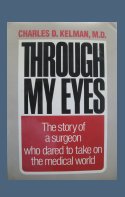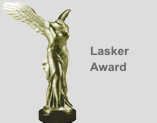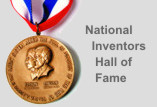

Lasker Award lauds Dr. Kelman for medical innovation
Oct 1, 2004 - By Ed Edelson, Ophthalmology TimesNew York—The 2004 Albert Lasker Award for Clinical Medical Research, given posthumously, honors Charles D. Kelman, MD, for transforming cataract surgery "from a risky and lengthy ordeal (2-week hospital stay) into a safe and quick outpatient procedure that has spared millions of people throughout the world from blindness," as well as for inspiring similar advances in a number of other medical specialties.
The award citation describes how Dr. Kelman began in the early 1960s to develop his concept for the removal of a cataract through a tiny slit, working on a $299,000 grant from the John H. Hartford Foundation. Experiment after experiment on cats failed. But just 6 months before the grant ran out, Dr. Kelman went to his dentist for tartar removal, done by a newly introduced ultrasound probe. The high-pitch buzz of that instrument gave Dr. Kelman the idea that an ultrasound instrument could pulverize the lens without damaging surrounding tissue.
He worked with engineers to adapt the probe for cataract removal, refining it into the phacoemulsification unit from which today's technology is derived. Dr. Kelman later enhanced the design of flexible lenses that unfurl within the eye, eliminating the need for the bulky glasses that had been essential after cataract surgery.
"Dr. Kelman's success marked a radical movement not only in cataract surgery, but in multiple medical specialties, turning myriad inpatient procedures into outpatient ones and bestowing on millions of people gifts of health and quality of life," the citation said. "Practitioners in other fields picked up on his idea of removing unwanted tissue through a tiny hole to improve, for example, gall bladder and joint surgery. Neurosurgeons have also adopted the emulsification machine to dissect tumors from the brain and spinal cord. Surgeries that used to require multi-week hospitalizations can now be performed in minutes, thus reducing the risk of life-threatening clots and difficult-to-treat hospital-acquired infections as well as other complications."
At the request of Dr. Kelman's widow, Ann, the monetary honorarium will be given to the International Retinal Research Foundation.
Ophthalmic Community Celebrates Dr. Kelman's Life
October 1, 2004 - Ophthalmology Times Colleagues, friends, family pay tribute to this 'extraordinary' individual
Colleagues, friends, family pay tribute to this 'extraordinary' individualNew York—It is not usual for a memorial ceremony to be punctuated by roars of laughter, but the commemoration held here on Sept. 13 for Charles D. Kelman, MD, was as unusual as the man himself. The tribute was as full of the liveliness, enthusiasm, and love that he expressed for everything in his life—from saxophone playing to song composing to helicopter piloting and to his medical and scientific studying that revolutionized ophthalmology.
Hundreds of colleagues and friends joined family members at the memorial tribute, held at the St. James Theater in the heart of the theatrical world. Program notes were provided by Dr. Kelman himself, taken from the Epilogue II for his autobiography, written last November as he was dying of the lung cancer that took his life on June 1, at the age of 74.
The ceremony was preceded by a bigger-than-life shot of Dr. Kelman playing "All the Things You Are" on the saxophone that he once intended be his career (until his father told him, "You can do anything you want—but first be a doctor," as he said in a later video clip.)
Family members spoke, starting with Ruth Kelman Dorfman, Dr. Kelman's sister, who said, "He loved life, and he loved his family. He was truly one of a kind."
Leslie Kelman Koeppe, his daughter, said her father "was always someone you could come to with a problem. He taught me to welcome and even embrace adversity. He had a rare and special gift that is hard to put into words."
"He created fun, laughter and easy times," said another daughter, Jennifer Kelman. "Even when he played games and acted silly, he was teaching us life's lesson."
She then read a tribute that was written by Dr. Kelman's 8-year-old son Evan, who stood at her side to hear her say of his father: "You were and still are the best dad in the world.... You are the greatest dad in the universe."
Then Ron Odrich, DDS, of New York, recalled that "the very first time I met him, 28 years ago, I knew I had a brother."
Dr. Odrich spoke about playing jazz together and how "he always did it his way, and he did it with a lot of joy."
Dr. Odrich was the first to speak of Dr. Kelman's invention of phacoemulsification, which changed cataract surgery from a many-day ordeal for doctor and patient to a simple outpatient procedure requiring no hospitalization, but which was met with immense initial skepticism.
Dr. Odrich recalled working in the laboratory with Dr. Kelman, and a presentation at a meeting that was "packed with unbelievers. But the evidence was irrefutable, and all of them turned out to be believers in the end."
Dr. Kelman's notes provided a conservative indication of the monetary savings that came from transforming cataract surgery into an outpatient procedure—at least $90 billion has been saved since 1985 by eliminating at least 5 days of hospitalization for 2 million operations per year.
Abraham H. Foxman, national director of the Anti-Defamation League, spoke of Dr. Kelman's close ties to his Jewish religion and to the state of Israel, typified by his contribution of up-to-date ophthalmologic equipment to hospitals there. Dr. Kelman, he noted, attended the United Nations meeting on anti-Semitism last year, an expression of "his close ties to the Jewish people and to yiddishkeit."
Roman Perez-Soler, MD, chairman of the department of oncology at Montefiore Medical Center in the Bronx, who treated Dr. Kelman after he was diagnosed with lung cancer, spoke more of Dr. Kelman as an active friend than as a patient. He recalled Dr. Kelman's "suspicion of the establishment and self-appointed experts," and how they became friends in the course of treatment.
Then came the music. Mel Mandel, lyricist for some of Dr. Kelman's many songs, introduced pianist Skip Kennon, who played as K.T. Sullivan and sang "Doesn't It Break Your Heart?"; George Dvorsky sang "A Man Among Men"; Alex Korey sang "Sandwich of Love"; and Evan Pappas sang "I Almost Died" and "Who You Really Are."
Then came one of those moments that had people laughing in spite of themselves, with a montage of Dr. Kelman, sometimes wearing a bushy false moustache, singing a self-mocking song, "My Business is Eye Business," starting with a Carnegie Hall appearance in 1976 and ending with a 1991 rendition.
Then came ophthalmology, again with a substantial accent on Dr. Kelman's creativity. William Tasman, MD, ophthalmologist-in-chief and professor of ophthalmology at Wills Eye Hospital, Philadelphia, recalled how he had been a resident with Dr. Kelman, with their chief, a difficult-to-impress Patrick J. Kennedy, MD, picking out Dr. Kelman as someone to watch on the basis of a conversation in 1958.
Music was still a central part of Dr. Kelman's life, Dr. Tasman remembered: "He wrote on an old upright piano that he somehow smuggled into the residents' quarters." But Dr. Tasman ended on a serious note, saying that Dr. Kelman's work had benefitted "millions on millions. Thank you, Charlie."
Professor Eric J. Arnott, DO, FRCS, London, remembered Dr. Kelman in 1958 describing phacoemulsification for cataract surgery, "which will take all the fun out of it."
Dr. Kelman later became godfather to Dr. Arnott's son.
Manus C. Kraff, MD, professor of clinical ophthalmology at Northwestern University, Chicago, met Dr. Kelman in 1972. It was a time, Dr. Kraff said, when the prevailing opinion was "if there were 100 ways to do cataract surgery, the 101st and worst way was phacoemulsification."
Dr. Kraff got permission to see the procedure done and, "I was mesmerized." He soon began doing phacoemulsification in Chicago.
He referred to Dr. Kelman as "my teacher and mentor," and truly the most influential ophthalmologist of the 20th century.
Frank Field, MD, medical correspondent for WWOR-TV in New York, sounded the keynote when he spoke of how "all of us have been touched by the warmth and brilliance of this extraordinary man."
Dr. Field told of meeting Dr. Kelman 40 years ago, after a particularly trying interview with a foreign physician whose accent made his English impossible to understand. Dr. Kelman, he recalled, was dressed in an outfit that featured bell-bottom trousers, so that "he looked like Elvis Presley."
When Dr. Kelman said he had a technology that could change cataract surgery from a 10-day ordeal to an outpatient procedure, Dr. Field said to himself, "Frank, this is not your day. This guy is either 'Looney Tunes' or a genius."
When Dr. Field described the new procedure on television, the station was inundated with telephone calls, he said, half from patients eager to have it done, the other half from "doctors who said he was crazy."
Robert J. Stevens, vice president for surgical products research and development at Alcon Laboratories, Fort Worth, TX, which markets many of Dr. Kelman's inventions, brought up the difficult side of the man, someone whose enthusiasm for his latest discovery occasionally had to be tamped down.
Stevens recalled jollying Dr. Kelman along on some occasions, but, he said, "for at least 20 years, it has been my blessing to be associated with him.
Many of Dr. Kelman's inventions, he said, "have become the standard of care globally." H. Dunbar Hoskins Jr., MD, executive vice president of the American Academy of Ophthalmology, San Francisco, said he had met Dr. Kelman in 1972, "when I was young and green."
Dr. Hoskins came to New York to take a course with Dr. Kelman. He and others in the course were left alone with 5 hours of video instruction.
"I had never seen a more organized teaching procedure," Dr. Hoskins said.
He remembers Dr. Kelman's "quiet persistence" in the face of almost universal skepticism, a time when "he never complained or railed about the opposition."
After one last Dr. Kelman song, "Butterfly," the memorial tribute came to a conclusion worthy of the man. Instead of weeping, the attendees were urged to give a hearty cheer, which they did for several minutes. And then it was announced that Dr. Kelman had received the latest of his many prizes: the 2004 Lasker Award, the American equivalent of the Nobel Prize.
Humanities & Arts

Through My Eyes The Charlie Kelman Story
Additional Information

Email for more information




